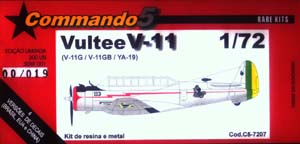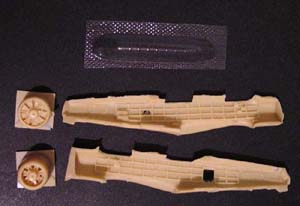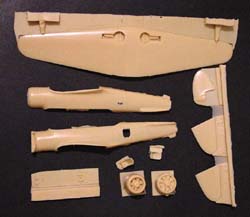Commando 5's 1/72 Vultee V-11G/V-11GB/YA-19
By Horcio Higuchi
 |

 |
 The kit comes in a standard, thin cardboard box that opens at the ends. All parts come protected in pieces of bubble wrap. The packaging is weak. The cardboard box is flimsy, and its size too tight a fit for the parts and their huge resin pours. This is one of those kits that are hard to put back into the box once you've unpacked their parts.
The kit comes in a standard, thin cardboard box that opens at the ends. All parts come protected in pieces of bubble wrap. The packaging is weak. The cardboard box is flimsy, and its size too tight a fit for the parts and their huge resin pours. This is one of those kits that are hard to put back into the box once you've unpacked their parts. The tailplanes are thin and wide, with no alignment aides-the dreaded butt-joint is the recommended method for attaching them to the fuselage. They look too thin to allow for any reinforcing pins to be inserted. Since the top surface of the horizontal empennage is perfectly flat and flush with the upper portion of the aft fuselage, I wonder why C5 didn't come up with a one-piece, full-span set of tailplanes (just like they did with the wings) to be sandwiched horizontally between the tail fin and the rear fuselage. It would have helped the assembly tremendously, and you wouldn't have any alignment or butt-joint headaches. Go figure.
The tailplanes are thin and wide, with no alignment aides-the dreaded butt-joint is the recommended method for attaching them to the fuselage. They look too thin to allow for any reinforcing pins to be inserted. Since the top surface of the horizontal empennage is perfectly flat and flush with the upper portion of the aft fuselage, I wonder why C5 didn't come up with a one-piece, full-span set of tailplanes (just like they did with the wings) to be sandwiched horizontally between the tail fin and the rear fuselage. It would have helped the assembly tremendously, and you wouldn't have any alignment or butt-joint headaches. Go figure. White Metal Parts
White Metal Parts Decals
Decals